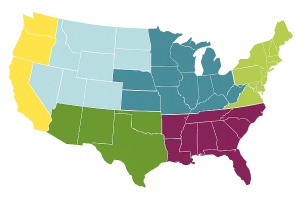Wisconsin Native Plants, State Flower & State Bird
Posted By American Meadows Content Team on Sep 27, 2012 · Revised on Oct 26, 2025

Knowing your location helps us recommend plants that will thrive in your climate, based on your Growing Zone.
Posted By American Meadows Content Team on Sep 27, 2012 · Revised on Oct 26, 2025
Native plants are adaptable, low-maintenance, and beautiful. They are the best choice for habitat-friendly gardens and thriving ecosystems. Find top picks for native plants in your state - and learn about your state bird and state flowers!
Follow Along With More Of Our Guides
Hello native plant enthusiasts! In the list below, you will find popular native plants and wildflower seeds, available from American Meadows, that have a native distribution in your state. You’ll also find information about your state bird, state flower, and state wildflower!
Grow our Native Midwest Wildflower Seed Mix
Virginia Bluebells (Mertensia virginica)
Showy Goldenrod (Solidago speciosa)
Wrinkleleaf Goldenrod (Solidago rugosa)
Perennial Lupine (Lupinus perennis)
Black Eyed Susan (Rudbeckia fulgida)
Black Eyed Susan or Gloriosa Daisy (Rudbeckia hirta)
Yellow Prairie Coneflower (Ratibida columnifera)
Gray Headed Coneflower (Ratibida pinnata)
Butterfly Weed (Asclepias tuberosa)
Swamp Milkweed (Asclepias incarnata)
Common Milkweed (Asclepias syriaca)
White Trillium (Trillium grandiflorum)
White Tinged Sedge (Carex albicans)
Firewheel (Gaillardia pulchella)
Blanket Flower (Gaillardia aristata)
Wild Strawberry (Fragaria virginiana)
Lowbush Blueberry (Vaccinium angustifolium)
Plains Coreopsis (Coreopsis tinctoria)
Lanceleaf Coreopsis (Coreopsis lanceolata)
Wild Bergamot (Monarda fistulosa)
Wild Geranium (Geranium maculatum)
Elderberry (Sambucus canadensis)
Phlox divaricata (Woodland Phlox)
Phlox subulata (Creeping Phlox)
Obedient Plant (Physostegia virginiana)
Red Cardinal Flower (Lobelia cardinalis)
Blazing Star (Liatris spicata)
Meadow Anemone (Anemone canadensis)
Anise Hyssop (Agastache foeniculum)
Bottlebrush Grass (Elymus hystrix)
Big Bluestem (Andropogon gerardii)
Little Bluestem (Schizachyrium scoparium)
Tufted Hair Grass (Deschampsia cespitosa)
Northern Sea Oats (Chasmanthium latifolium)
Yellow Prairie Grass (Sorghastrum nutans)
Smooth Blue Aster (Symphyotrichum laeve)
Aromatic Aster (Symphyotrichum oblongifolium)
New England Aster (Symphyotrichum novae-angliae)
Common White Yarrow (Achillea millefolium)
Heliopsis (Heliopsis helianthoides)
Purple Prairie Clover (Dalea purpurea)

Robin ~ Turdus migratorius
The Robin nestlings grow quickly. At two weeks they are well feathered and show the spotted breast of their juvenile plumage. Only in youth do Robins wear these markings that indicate their kinship to other thrushes. The fledglings face a critical time when they must quit the nest. Before they can fly they must outmaneuver cats, dogs, hawks, snakes, and other predators. For a few days the male parent looks after them while the female prepares for a second brood.
Wood Violet ~ Viola papilionacea
Wisconsin’s Violet has upper petals that are a deeper shade of purple than the lower ones. These Violets have five petals – one upper pair and, below them, another pair separated by a broader petal. This center petal is elongated to form a spur and is wide enough to act as a platform for visiting insects. The honey guides marked on it lead to the nectar in the spur. As the insects feast, pollen brought from another flower is brushed from them. As the Violets fade, the leaves grow taller. In many varieties, short-stemmed buds develop, but never open.
From The Wildflowers of the 50 States U.S. stamps issued July 24, 1992:

